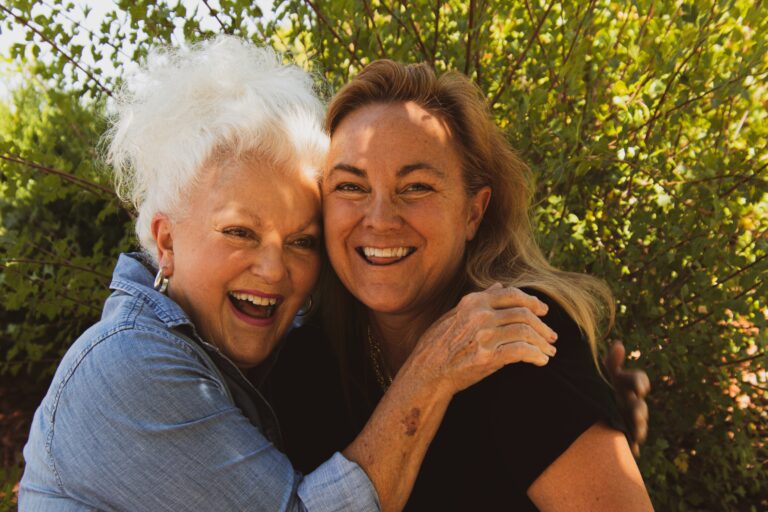Caring for an aging loved one is a journey filled with love, devotion, and at times, significant challenges. For many adult children and spouses, there comes a point where the caregiving responsibilities exceed what they can manage. This realization often brings a mix of emotions: guilt, sadness, and concern. Yet, it’s a reality faced by many. According to the Long-Term Care in America report (PDF), a staggering 88% of Americans prefer to receive ongoing living assistance at home as they age. However, the same report highlights that only 31% have discussed their preferences for care with family and friends, and a mere 11% with their healthcare providers, indicating a gap in planning and communication.
The preference for aging at home, especially post-pandemic, has become increasingly prominent. The pandemic saw a rise in telehealth services, with 53% of Americans receiving some form of virtual healthcare. Despite this trend towards home-based care, the practicalities and emotional toll on family caregivers can be overwhelming. Recognizing when professional help is needed isn’t just a practical decision but a compassionate one, ensuring your loved one continues to receive the care and support they deserve.
In this article, we delve into the signs that indicate it might be time to explore alternative care options, the variety of care choices available, and the financial considerations involved. Importantly, we’ll discuss how to approach this sensitive topic with your loved one, emphasizing the necessity of maintaining their dignity and autonomy in the decision-making process. Our goal is to provide a roadmap for those facing the challenging transition from being a primary caregiver to finding and accepting external care support for their aging loved one.
As we delve into understanding when it might be time to transition away from the role of primary caregiver, it’s important to reflect on our previous discussion in ‘The 7 Signs That Your Loved One Needs Home Care Assistance’. While that article explored the critical indicators that an aging loved one requires more support, it’s equally vital to turn the lens inward. As caregivers, acknowledging our own limits is not a sign of weakness, but rather a courageous act of love and responsibility. Let’s explore the often-overlooked signs indicating that a family caregiver may need to consider transitioning from their role, for their well-being and the sustained care of their loved one.
Emotional and Physical Exhaustion:
If you’re constantly feeling drained, both emotionally and physically, despite adequate rest, it could be a sign of caregiver burnout. This exhaustion often goes beyond normal tiredness and can manifest as a lack of energy, feeling run down, and a sense of being overwhelmed by your caregiving duties.
Health Deterioration:
Caregivers might experience a decline in their own health, such as frequent headaches, weight fluctuations, sleep disturbances, or chronic pain. Ignoring these symptoms can lead to serious health problems, indicating the need for a change in the caregiving situation.
Mental Health Struggles:
Signs of depression, anxiety, irritability, or a sense of hopelessness are common among caregivers. If you’re experiencing persistent sadness, mood swings, or loss of interest in activities you once enjoyed, it’s crucial to consider these as serious signals.
Feeling Resentful:
If you find yourself feeling resentful towards the senior you are caring for, or feeling that your life revolves only around caregiving, it might be time to reassess your role. Resentment can build up over time, impacting your relationship with your loved one and your ability to provide compassionate care.
Social Withdrawal:
Neglecting your social life, hobbies, or activities you enjoy due to caregiving responsibilities is a red flag. Isolation can lead to feelings of loneliness and can be detrimental to your mental health.
Decreased Patience and Increased Frustration:
If you notice you’re losing patience more quickly, getting easily frustrated or angered by minor issues, or feeling overwhelmed by caregiving tasks that used to be manageable, these are strong indicators of caregiver stress.
Difficulty Balancing Other Responsibilities:
Struggling to juggle caregiving with other responsibilities like work, family, and personal care is a sign that the caregiving demands are too high. This often leads to a feeling that you’re failing to meet all your commitments effectively.
Lack of Personal Time:
If your entire schedule is consumed by caregiving tasks, leaving little to no time for yourself, it’s a clear sign that the responsibilities are too burdensome. Personal time is crucial for mental and emotional well-being.
Feeling Guilty for Taking Time Off:
If the thought of taking time off for yourself makes you feel guilty or anxious about your loved one’s well-being, it suggests an unsustainable caregiving situation.
Recognizing these signs in yourself is just as important as recognizing the care needs of your loved one. It’s essential for caregivers to acknowledge when the demands of caregiving become too great and to understand that seeking additional help is a responsible, necessary, and compassionate decision. Remember, taking care of yourself is not a luxury, but a vital aspect of providing effective care for your loved one.
Exploring Care Alternatives for our Loved Ones
When it becomes apparent that a family caregiver can no longer solely manage the care of an aging loved one, exploring alternative care options becomes essential. Let’s consider the various possibilities that align with the growing preference for home-based care, as emphasized in the Long-Term Care in America report.
Understanding the strong preference among seniors to age in their own homes is crucial when considering care alternatives. The Long-Term Care in America report highlights that a significant 88% of Americans prefer to receive ongoing living assistance at home or in a loved one’s home. This overwhelming preference underscores the need to consider care options that align with the desire for familiarity and comfort.
Why Home Care is a Preferred Option:
Familiar Environment: Aging in place allows seniors to stay in a familiar, comfortable setting, which is particularly beneficial for those with cognitive impairments like dementia.
Personalized Care: In-home care provides personalized attention tailored to the individual’s specific needs and routines, promoting a sense of independence and control.
Flexibility: Home care services offer flexibility, from a few hours a week to round-the-clock care, accommodating varying levels of need without the upheaval of moving to a new residence.
Cost-Effectiveness: For many, home care can be more cost-effective than residential care facilities, especially for those requiring only part-time assistance.
Emotional Well-being: Staying at home can contribute positively to emotional and mental health, as it maintains established social networks and community ties.
In-Home Care Services:
Reflecting these benefits, in-home care services can include professional caregivers, home health aides, and companion services, each offering different levels of support while respecting the senior’s preference for home-based care.
Telehealth Services:
With 53% of Americans having used telehealth services during the pandemic, as noted in the Long-Term Care in America report, integrating these services into the care plan can further enhance the feasibility of aging in place, ensuring access to medical advice while minimizing the need for physical hospital visits.
Adult Day Care Centers and Respite Care:
For caregivers who need to balance work or other responsibilities, adult day care centers and respite care services offer a viable solution, allowing seniors to receive care and social interaction during specific times, while still maintaining their home as their primary residence.
Assisted Living and Specialized Care Facilities:
While these options involve moving out of the home, they can be considered when the level of care required surpasses what can be feasibly provided at home. These facilities offer a compromise between independent living and nursing homes, with many now offering a home-like atmosphere and personalized care.
In exploring these alternatives, it’s important to weigh the benefits of each option against the specific needs and preferences of the senior. The overarching goal is to respect their desire to age in place as much as possible, providing the support they need to do so safely and comfortably.
Financial Considerations for Elder Care
Navigating the financial aspect of elder care is a critical component of planning for your loved one’s future needs. Understanding the roles of various funding sources, such as Medicare, Medicaid, Veterans Affairs, and private insurance, is crucial in making informed decisions.
Medicare and Medicaid:
Medicare: Primarily provides health coverage for seniors aged 65 and older. While it covers short-term skilled nursing care and rehabilitative services, it’s important to note that Medicare does not typically cover long-term care costs.
Medicaid: Offers coverage for low-income individuals, including long-term care services. Eligibility and benefits vary by state, but Medicaid can cover costs that Medicare does not, such as long-term nursing home care and some home and community-based services.
Veterans Affairs (VA) Benefits:
For veterans and their spouses, the VA provides various benefits that can assist with elder care. This includes Aid and Attendance benefits, which offer additional financial support to veterans who require assistance with daily activities.
Private Insurance and Long-Term Care Insurance:
Private health insurance policies generally do not cover long-term care. However, long-term care insurance is designed specifically to cover services that traditional health insurance does not, including in-home care, assisted living, and nursing home care.
Public Views on Funding for Long-Term Care:
The Long-Term Care in America report reveals that the public supports various government actions to help cover long-term care costs. For instance, 60% favor a government-administered long-term care insurance program similar to Medicare.
Additionally, there is significant support for government funding for programs that allow people with low incomes to receive care at home, reflecting the preference for home-based care solutions.
Insurance Responsibilities and Public Opinion:
The report also indicates that 52% of Americans believe health insurance companies should have a large responsibility in paying for ongoing living assistance, with 51% saying the same about Medicare.
Interestingly, while there is a reliance on these programs, there’s also a recognition that individuals (35%) and families (15%) should bear some responsibility for these costs.
Understanding these financial resources and public opinions helps in planning and preparing for the different stages of elder care. It’s essential to explore all available options, including government programs, insurance policies, and benefits for veterans, to develop a comprehensive financial strategy for your loved one’s care.
Having the Conversation about Hiring A Caregiver
Initiating a conversation about care changes with an aging senior can be delicate and emotional. It’s important to approach this discussion with respect, empathy, and clear communication. Here are some strategies to guide this crucial conversation:
Choose the Right Time and Setting:
Select a time when both you and your loved one are relaxed and not rushed. The setting should be private and comfortable, free from distractions.
Express Your Feelings and Concerns:
Start the conversation from a place of love and concern. Share your feelings and the challenges you are facing as a caregiver. Be honest about your limitations and the need to consider additional care for their well-being and your own.
Listen Actively:
Give your loved one the opportunity to express their feelings and concerns. Listen actively, showing that you value their opinions and feelings.
Emphasize the Positive Aspects:
Highlight the benefits of additional care, such as improved safety, more social interaction, and access to professional medical support.
Discuss Care Options:
Present the various care options available, ensuring that your loved one understands each one. Allow them to be part of the decision-making process, respecting their preferences and autonomy.
Involve Healthcare Professionals:
Consider involving a healthcare professional or counselor in the discussion. They can provide an objective perspective and help clarify the medical and care needs that are influencing this decision.
Focus on the Needs of the Family Caregiver:
Clearly explain that this conversation and the potential changes are also about addressing your needs as the family caregiver. Emphasize that seeking additional help is a way to ensure that you can continue to support them effectively, without compromising your own health and well-being.
Prepare for Resistance:
Be prepared for some resistance or emotional responses. Reassure your loved one that their best interests are at the heart of this decision.
Plan for Ongoing Discussions:
Understand that this may not be a one-time conversation. Be prepared for ongoing discussions as your loved one processes this information and as their needs evolve.
Document Agreed Decisions:
After reaching a decision, document the agreed-upon care plan, ensuring everyone involved understands the next steps.
By approaching this conversation with empathy, respect, and clear communication, you can help ease the transition for your loved one and ensure that the chosen care solution aligns with their needs and preferences. If you need additional guidance on how to hire a caregiver, what you should look for and the kind of questions to ask, check out The Compassionate Guide to Why and How to Hire an In-Home Care Agency.
Legal and Medical Elder Planning
Legal and medical planning are essential aspects of caregiving and aging. Having these documents in order ensures that the senior’s wishes are respected and legally protected.
Importance of Legal Documents:
- Documents like Power of Attorney (POA) and living wills allow seniors to designate someone to make decisions on their behalf if they become unable to do so. This can cover financial, health, and legal decisions.
- Advance directives outline a person’s preferences regarding medical treatments and interventions. They are crucial in ensuring that the senior’s healthcare wishes are followed.
End-of-Life Care Discussions:
- Engage in conversations about end-of-life care and preferences. These discussions, while difficult, are important to ensure that everyone is clear about the senior’s wishes.
- Consider consulting legal professionals to help in setting up these documents correctly and ensuring they are legally binding.
If you are in the Austin area, we have a few well regarded Elder Care and Estate attorneys in our Senior Kare Expert Resource Guide.
Caregiver Emotional Support and Self-Care
Caring for an aging loved one is a rewarding but often challenging journey, making emotional support and self-care vital. It is hard to fill a cup from an empty vessel. Giving care when you are struggling with your own self care and are emotionally drained is quite the challenge.
Emotional Support for Both Parties:
- Emotional support is crucial for both the caregiver and the senior. Regular check-ins and open communication can help address emotional needs.
- Consider professional support, such as counselors or therapists, who specialize in caregiving and elderly care issues.
Self-Care Tips:
- Prioritize your well-being by taking breaks, engaging in hobbies, and maintaining social connections.
- Join support groups where you can connect with others in similar situations.
- Regular exercise, a balanced diet, and sufficient sleep are crucial for maintaining physical and mental health.
Transitioning Care From Family Caregiver To A Professional Caregiver
Transitioning to a new care arrangement can be challenging for both the caregiver and the senior. Planning and support can make this transition smoother.
Gradual Introduction to New Caregivers or Communities:
- Introduce new caregivers or community settings gradually. Allow the senior to become accustomed to new faces and routines slowly. You should consider having a caregiver for just a couple of hours a day to begin.
- Visit assisted living facilities or communities together, discussing what each offers and how it aligns with the senior’s preferences.
Role of Family and Friends:
- The support of family and friends is invaluable during this transition. They can offer emotional support, assist with decision-making, and help in maintaining a sense of continuity and normalcy.
- Arrange for family members to visit or stay in touch regularly, helping the senior adjust to the new care arrangement.
Navigating the journey of caregiving for an aging loved one brings a myriad of emotions and decisions. From recognizing the signs that it’s time to transition out of the caregiver role, to understanding the various care options available, and addressing the financial implications, this journey is complex and multifaceted. Legal and medical planning are critical to ensure that your loved one’s wishes are honored, and self-care for caregivers is equally important for sustaining the ability to provide support.
We have explored the significance of having open and respectful conversations about care changes, emphasizing the importance of involving healthcare professionals to facilitate these discussions. Additionally, we’ve touched upon the essential role of emotional support and the strategies for a smooth transition to new care arrangements, underscoring the value of family and friends’ involvement.
It’s important to remember that seeking additional care is not only a responsible decision but also an act of profound caring. It ensures that your loved one continues to receive the best possible care while maintaining your well-being. This transition, though emotionally challenging, is a part of the caregiving journey that many face.
Additional Resources:
For further support and information, the following resources can be invaluable:
Caregiver Support Groups:
Financial Aid and Insurance Information:
- Medicare.gov – Long-Term Care Planning
- Benefits.gov – Senior Citizens’ Resources
- VA – Services for Veteran’s
Elder Care Services:
Legal and Medical Planning:
- National Academy of Elder Law Attorneys
- Advance Care Planning – HealthFinder.gov
These resources offer valuable information and support to help navigate the complexities of caregiving, ensuring you and your loved one find the right path forward in this journey.
📸 Image by Freepik

From a young age, Stacey’s link to the senior care industry grew alongside her mother’s work at a nursing home, where she often accompanied her. By her early teens, she secured her first official job at a nursing home, laying the foundation for a profound journey in senior care spanning over four decades. Her roles varied from opening assisted living and memory care residences to working in nursing homes and independent senior living communities. As the former Director of Fun for 300 independent seniors, she expertly organized daily events and trips. Stacey’s unwavering passion, nurtured by her family, and professional dedication as a recreation therapist, reflect her deep commitment to preserving the dignity and well-being of seniors.
Stacey’s senior care expertise has been recognized by the media including U.S. News and World Report and Care.com.
Stacey and her husband Bryan are the owners of the senior in-home care agency A Place At Home – North Austin.




